Experiment: The Mystery of Blue Raspberry Flavor
Is it fully artificial, or related to the rare black raspberry? 🔵
INTRODUCTION
Blue raspberry is a common artificial flavoring, typically paired with brilliant blue FCF coloring (a.k.a. FD&C Blue No. 1). There is no such thing as a blue raspberry in nature, at least nothing resembling brilliant blue FCF, which has led to speculation about what blue raspberry flavor is supposed to be or where it comes from.

There is minimal academic literature on blue raspberry flavor. As far as I can tell using both Elicit and Google Scholar, the only scholarly article offering a treatment of the topic is Charles Spence’s “What's the Story With Blue Steak? On the Unexpected Popularity of Blue Foods” (2021), which has a short section about blue raspberry. The section mostly relies on a popular web article from 2016 by Michael Y. Park on Bon Appétit, “What Even Is Blue Raspberry Anyway?” In fact, it seems that virtually all discussion of blue raspberry in popular articles as well as Wikipedia ultimately traces back to Park 2016.
And unfortunately, neither Park 2016 nor the handful of other sources really gives great intel on what flavor blue raspberry is supposed to be. We do have information on when and by whom it was invented — it dates from the 1950s and became popular after 1970. But the why and what remain elusive:
The earliest mention of blue raspberry is as a cotton candy flavor by the company Gold Medal, in 1958. “Unfortunately,” Park writes, “Gold Medal's spokeswoman Heather Gims says there's no one still at the family-run company who can remember anything about how Gold Medal got into the blue raspberry business.”
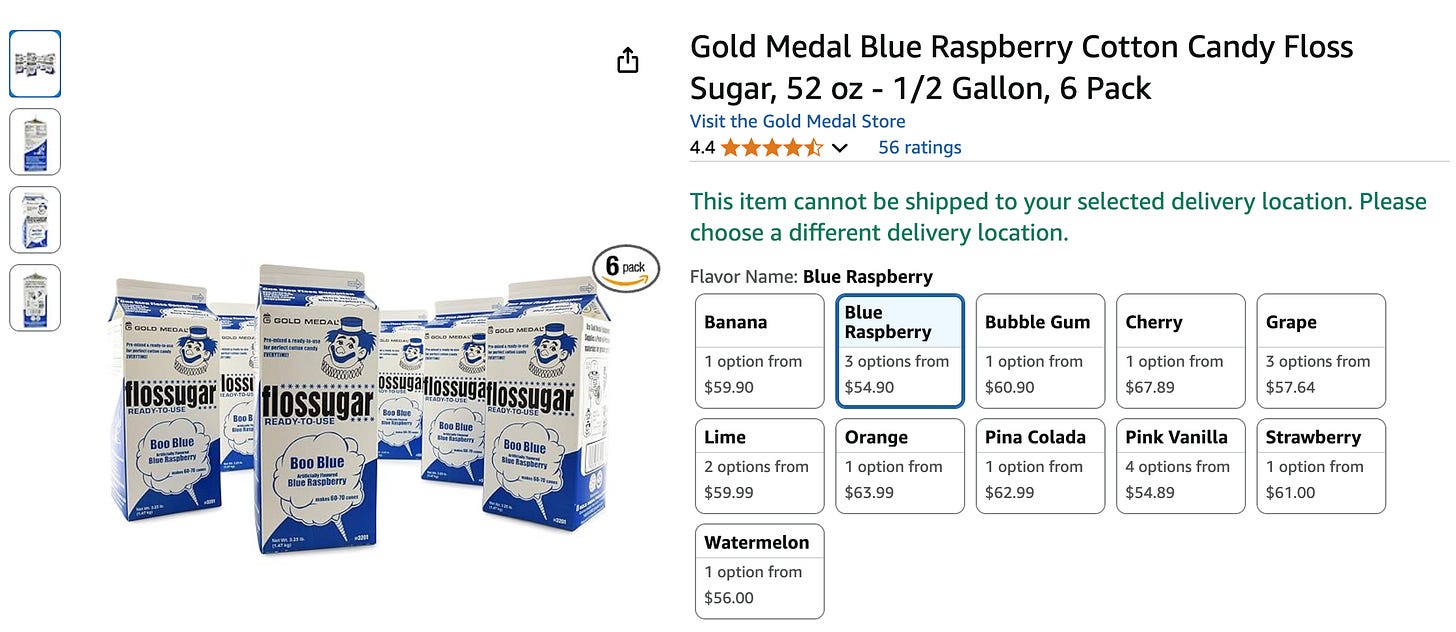
The flavor was further popularized around 1971 by The ICEE Company for frozen slushie drinks. The other flagship color of ICEE was cherry, so apparently they wanted a distinct color for their raspberry product, and one that would match the ICEE logo. Besides, FD&C Blue No. 1 had conveniently just become approved by the FDA.
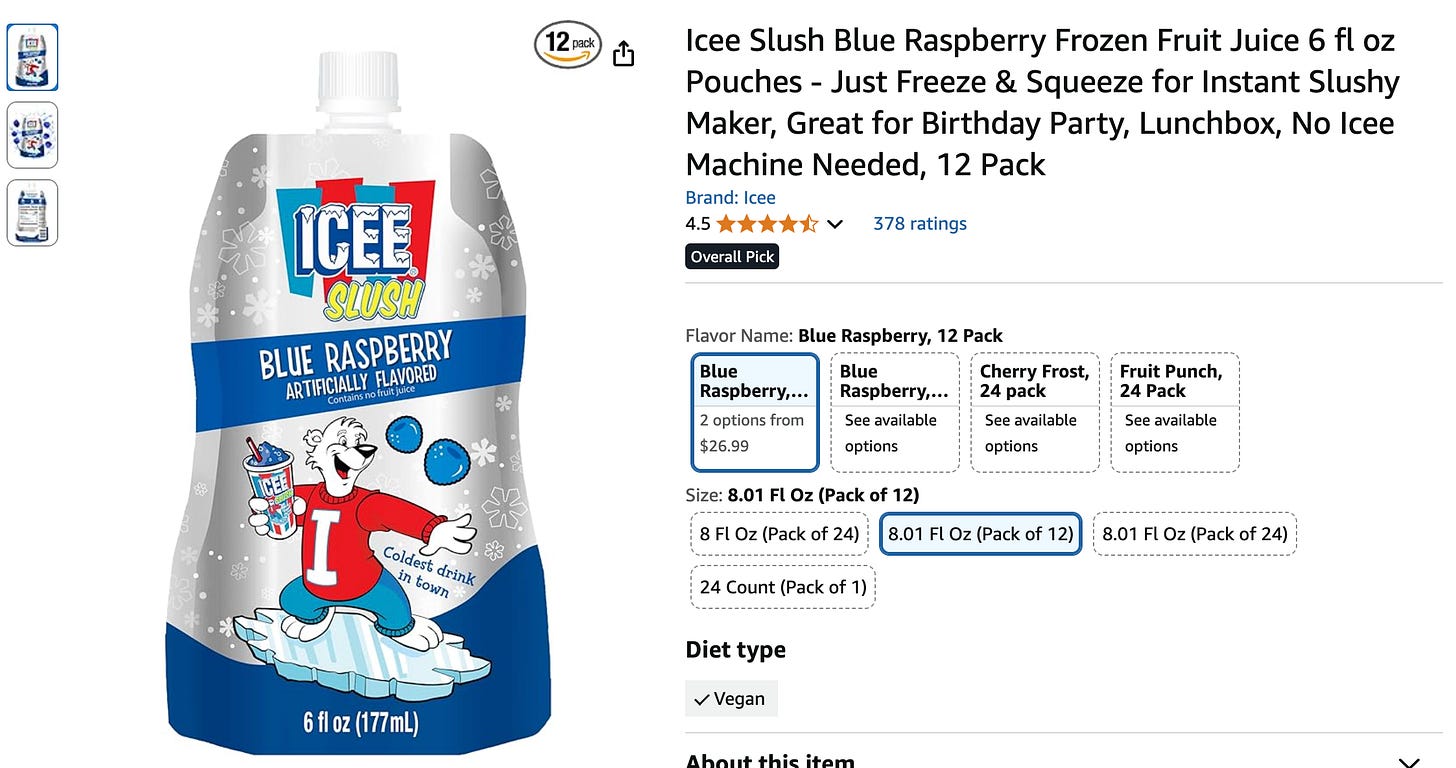
Around the same time (1970), Otter Pops introduced freeze pops in various flavors, including blue raspberry. “Unfortunately,” Park writes, Laura Trevino (marketing director at Jel Sert, which owns Otter Pops) “didn't manage to track down any company records explaining the Otter Pops bosses' decision making.”
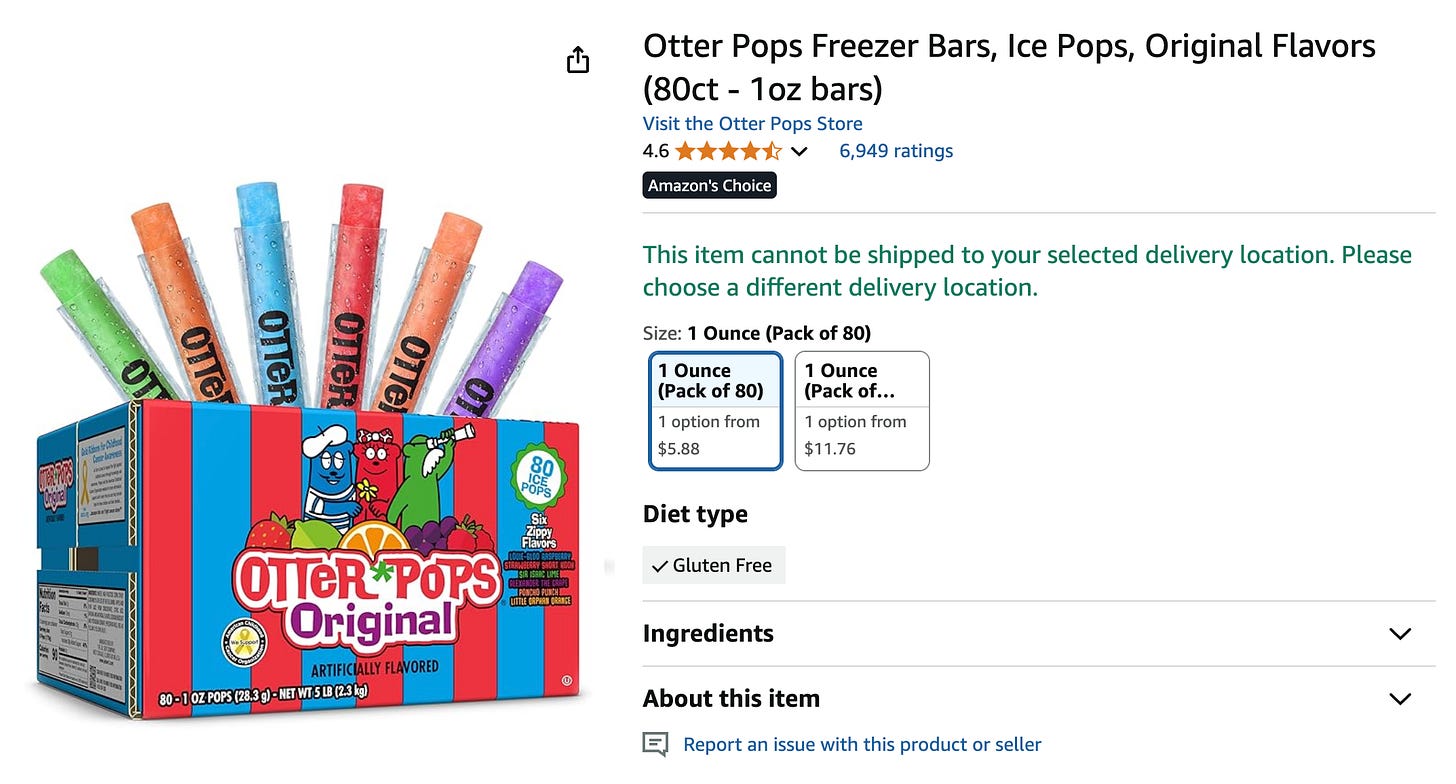
So we have a tiny bit of info on ICEE’s rationale, and basically none about Gold Medal or Otter Pops because everyone forgot about it. We are left to speculate. Wherefore blue raspberry? Several hypotheses coexist:
Red raspberry: Blue raspberry may be regular raspberry flavor, except colored blue rather than red due to either (or a combination of):
Reducing competition with other “red” flavors (cherry, strawberry, cranberry, cinnamon, etc.)
The banning of amaranth red coloring, FD&C Red No. 2, a dark red color that had been used for raspberry products. The FDA banned it in 1976 due to growing health concerns, so later than the appearance of blue raspberry, but that may have contributed to spreading the blue version. Amaranth red is still used outside the US, however.
Trying to match the red-and-blue logo of ICEE
Wanting to use the newly approved brilliant blue FCF color, and raspberry was as good a choice as any
Random other fruit: Blue raspberry, possibly like red raspberry artificial flavor, may be derived not from natural raspberries, but from a combination of chemicals from other fruit. Park writes that “according to Jerry Bowman, executive director of the Flavor & Extract Manufacturers Association of the United States, the flavor profile of raspberry was actually developed using ‘mostly esters of the banana, cherry, and pineapple variety.’”
Rubus leucodermis: Blue raspberry may have been inspired by a real species of raspberry that isn’t the common cultivated one (Rubus idaeus). Instead it was inspired by the taste of Rubus leucodermis,1 also known as the whitebark raspberry, blackcap raspberry, or (wait for it) blue raspberry. Note that this fruit isn’t the same as blackberries, and is much rarer! Some sources mentioning this possible inspiration:
An old web page from the North Dakota State University states that blue raspberry flavor “mimics the flavor of blackcap raspberry Rubus leucodermis, a wild berry most of us have never seen or eaten.”
This 2022 article by Lauren Rothman says that: “The tangy flavor of whitebark raspberries may have inspired the blue raspberry flavor, at least in part. These purple types taste more like blackberries than red raspberries, though, and if you've ever had a blue raspberry ICEE, you know that you get a jolt of sweetness when you take a sip, unlike the more sour whitebark fruits. So, while the purple berries may have sparked the imagination of the inventors of blue raspberry, each brand now has its own version of the artificial flavor”.

Not R. leucodermis: Blue raspberry may not have been inspired by R. leucodermis, because that makes no sense:
It doesn’t seem to be commercially cultivated
The color isn’t closely related to brilliant blue FCF
It’s from the West Coast, but Gold Medal is from Cincinnati. (ICEE was originally founded in Los Angeles, so maybe there’s a connection.)
R. occidentalis: Blue raspberry may have been inspired by another, closely related species to R. leucodermis, R. occidentalis or the black raspberry. Despite its Latin name, it grows in eastern North America, where it is also commercially produced at a small scale.
Okay I didn’t actually see any serious articles claiming this, but there is this Reddit thread,2 and also my own experience eating them.

Other Rubus sp.: Or, blue raspberry could have been inspired by other Rubus species, like R. niveus or R. coreanus, although this seems unlikely if they’re not from North America.
Which one(s) of these is (are) correct? Without information from the archives of the companies that came up with blue raspberry, it seems like the only path forward is a taste test. So get ready for some Science!
METHODS
Last year in July I bought some black raspberries (presumably R. occidentalis, based on appearance, location, and the fact that I don’t think other types of black raspberries are cultivated commercially) from the Jean-Talon Market in Montreal. I thought they tasted somewhat like blue raspberry flavor, and decidedly different from red raspberries, so I thought it would be cool to perform a taste test to compare them with blue raspberry candy, and then write a post about it. So I went back to the market, where I was told that the black raspberry season was over. It apparently lasts for 3 days or something. So I put a big alert saying BLACK RASPBERRIES in my calendar for a year minus a week later, 12 July 2025. Because I was traveling to see my parents on 12 July this year, I went to the market on 11 July, just in case. Where I was promptly told that the season was already over!!! I guess raspberry season was early this year. Luckily, for some reason they still had two boxes hidden behind the counter, and they agreed to sell me one for $5.
I also bought some locally grown red raspberries for comparison purposes, and then I went to a candy store and asked the clerk to show me everything that was labeled as “blue raspberry.” She said that “anything that is blue is blue raspberry” (and then showed me a random example that turned out to be blueberry). For rigor, I decided that I’d only buy candy that was explicitly labeled as “framboise bleue.” I got these four kinds:
I then traveled to my parents’ home and recruited a representative sample of tasters from the people in the area (myself, my mom, my dad, my brother, my sister-in-law, and my 5-year-old and almost-4-year-old nephews). I cut small pieces of each candy and arranged them like this, the idea being that everyone would try a raspberry, then the candy, then have the raspberry again, and do this for each combination or red/black raspberry and candy type.
I asked everyone to give a 1 to 5 rating in taste similarity for each combination, and give their intuitive impressions on whether black raspberry could be causally related to blue raspberry flavor.
RESULTS
Concerns were raised over the reliability of the two youngest tasters, so I unfortunately had to throw out their ratings, leaving a sample of n=4.
The results are shown in this figure, where circles are the individual ratings (with some jitter to view them better, but they’re all integers) and squares are averages (not necessarily integers):
Some things to note:
The “spiral” and “mini” candy types were deemed much more similar to black raspberries than red raspberries.
The “pie” type wasn’t much similar to either real fruit (honestly it just tasted like sugar and was kind of gross).
The Airheads candy was somewhat similar to both.
Overall, across candy types, the candy was more similar to black raspberries than red, but probably not enough to be a meaningful difference (to say nothing of statistically significant lol).
DISCUSSION
My hypothesis was that the taste of black raspberries would more similar to the candy than the taste of red raspberries was, supporting the idea that the original makers of blue raspberry flavor got inspiration either from R. occidentalis or (presumably similar-tasting) R. leucodermis.
The results don’t really support this. There may be an association, but it’s a weak one, whereas I was hoping for something obvious. When I had black raspberries in isolation, it was easy for me to think that this was totally the same as blue raspberry flavor. But none of the other tasters was particularly convinced. I asked them if they thought, in light of the test, whether it was plausible that black raspberries inspired blue raspberry; the three of them said no, not really. (I didn’t ask my nephews.)
This silly study comes with a number of limitations, including that I was one of the testers and was trying to get a positive results (so maybe my ratings should be downgraded by 1 point!), it wasn’t a blind test, and we had low sample size. It could also have been useful to have more candy, or more non-candy blue raspberry foods (slushies, sports drinks, etc.). Black raspberries from different sources would have been good too; it was pointed out to me that the blackberries had a pretty weak taste, and maybe there are better varieties or specific harvests out there. (On the way to my parents’, I stopped by a farm that I knew had them, in order to get a second source. Sadly, I got there 20 minutes after they had closed for the day.)
But I’m not super interested in trying to p-hack my way into finding an association. It seems likely that the null hypothesis is true, and blue raspberry flavor doesn’t come at all from R. occidentalis (and probably not from R. leucodermis or other species, though I don’t know if they taste similar to R. occidentalis). It’s still pretty weird how neither the taste nor the color of blue raspberry have anything to do with raspberries. I guess we can only hope that someone miraculously finds archived documents at Gold Medal or the other companies so that we can finally shed light on this most pressing issue.
Confusingly for those who know their Greek roots, leuco means white, but the fruit is black-ish. (Leucodermis refers to the white bark.)
u/Syntaximus in the Reddit thread claims that “You can also turn them slightly blue by adding a base like baking soda” to neutralize the acidic reddish juice. I tried this. It sort of works. Compare, in the picture below, the two whole raspberries and their fresh juice to the left, with the pile of raspberry purée mixed with baking soda and the smattering of dark blue juice at the top:
I let the plate sit in the warm July weather for a couple of hours and eventually it turned some weird shade of yellowish-bluish gray.



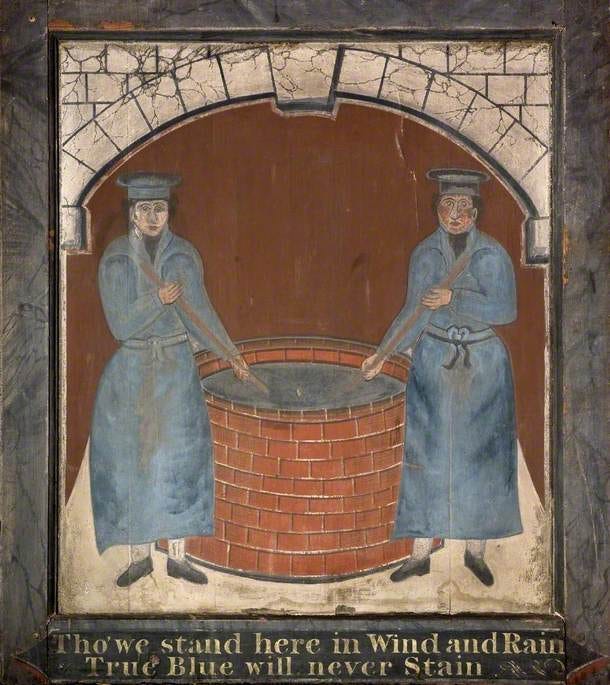
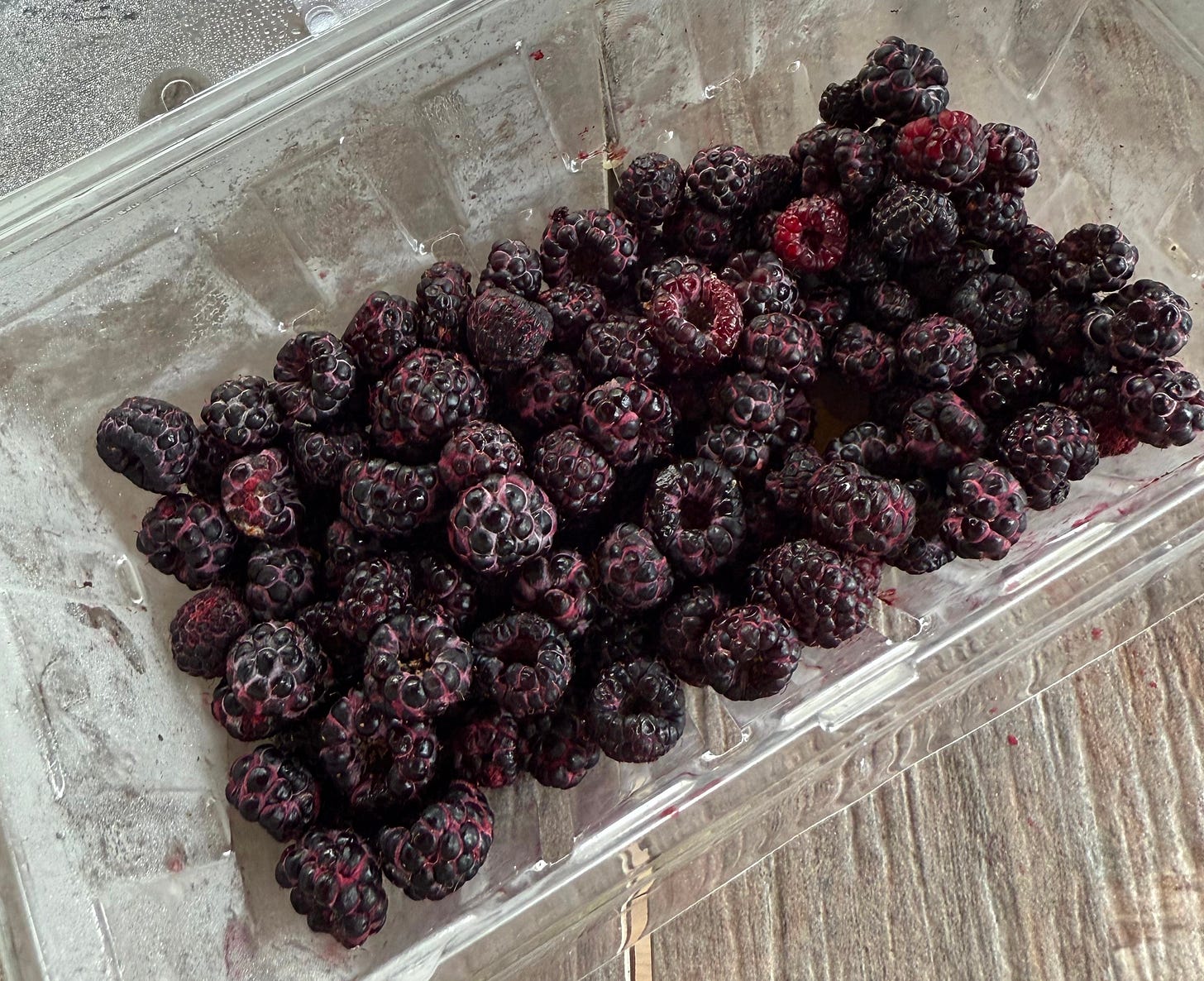
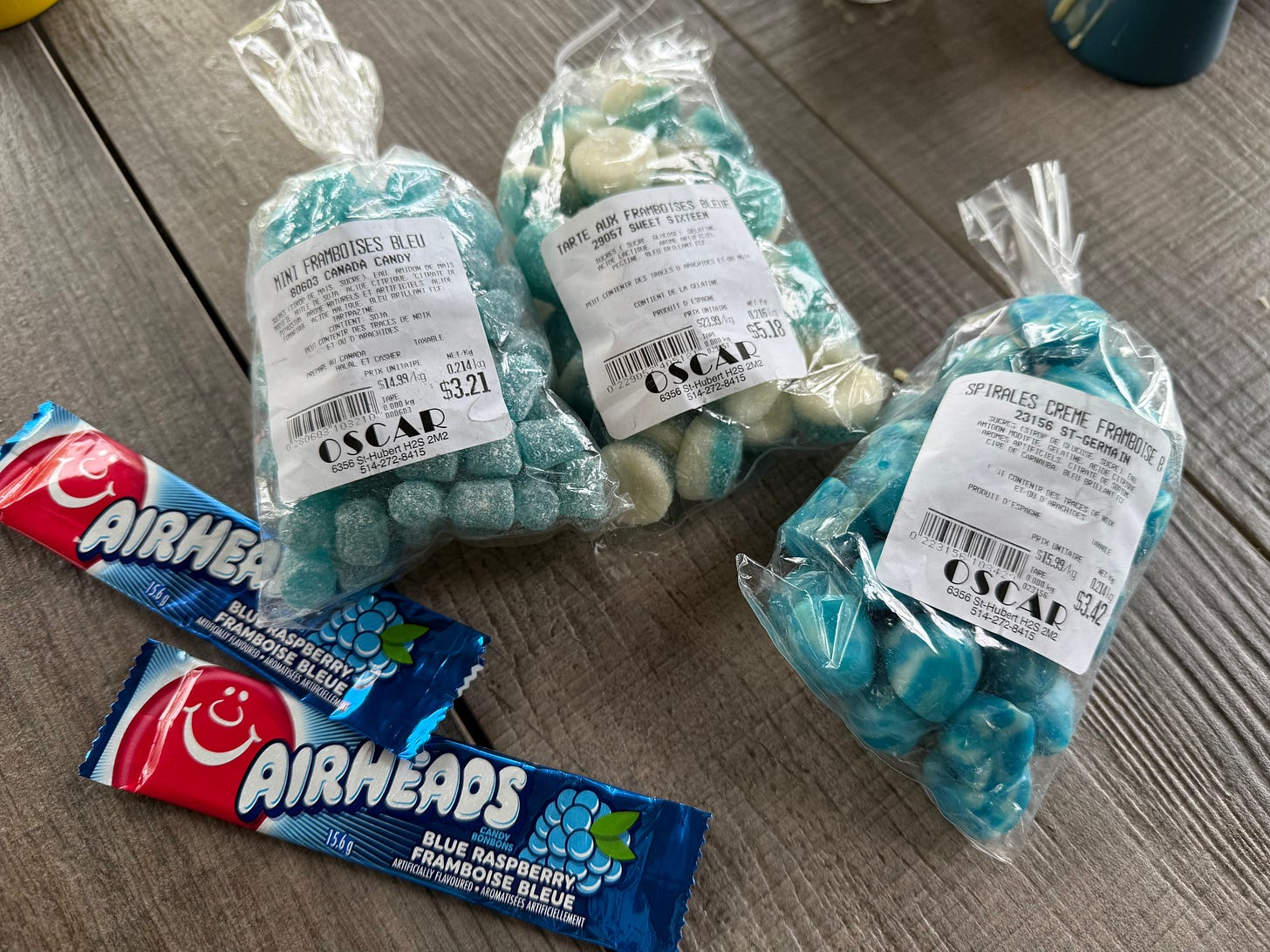

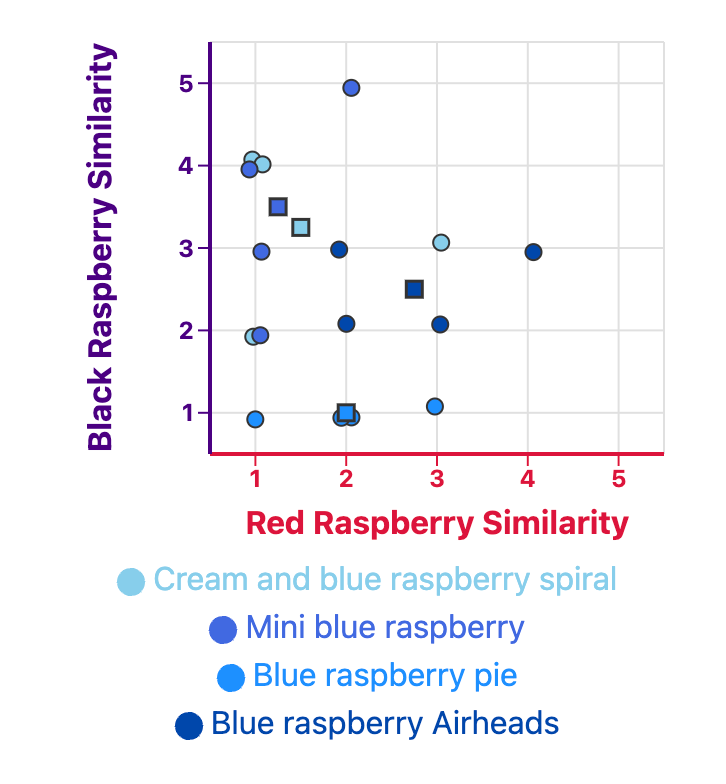

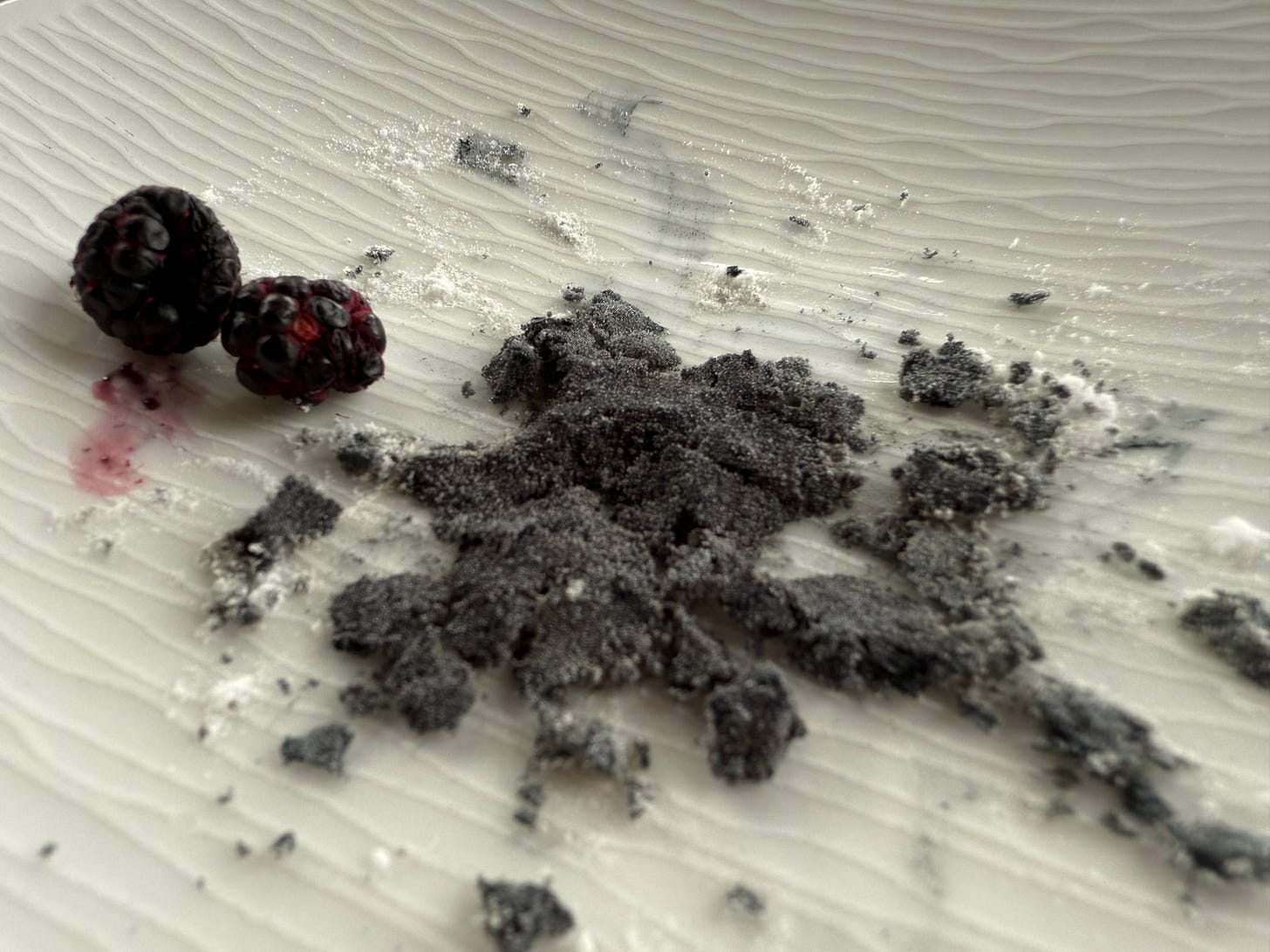
I'm leaning towards marketing by association. They landed on a good flavor, and called it a sister of the next closest thing. Later taste technicians left it all to marketing, and so we get the infamous Baha Blast.
Makes me wonder though, could they have been associating *other* less known fruit to a familiar name? I've never had straight boison berry, bilberry, huckleberry, service berry or such to compare.
Completely aside, I recommend trying the fruit of dogwood trees. Looks like a raspberry, but its practically a small persimmon. Close relative, and needs the same long ripening for maximum flavor.
What a wonderfully delightful and surprising read! I have often wondered about this dubious blue raspberry business and I've decided (for no reasons other than it pleases me) to accept your hypothesis wholeheartedly.